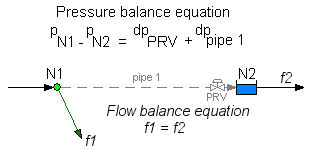Pressure Reducing Valves
Pressure Reducing Valves allow the user to set a pressure at the node downstream of the valve (i.e. at the end of the pipe). The pressure reducing valve (PRV) introduces an additional pressure loss in the pipe to control the pressure at the node downstream of the valve to the value specified by the user.
A pipe with a Pressure Reducing Valve fitted cannot have a tank or pressure demand set on either end. No other pipe which connects to a pipe with a Pressure Reducing Valve fitted can contain a control valve (FCV, PRV or BPV).
Pipe Flow Expert removes the pipe from the system and sets the pressure at the downstream node (N2) by replacing it with an appropriately defined tank. The tank elevation is set to equal the node elevation, the liquid level is set to zero and the fluid surface pressure is set to the pressure reducing valve setting. At the upstream node, an out-flow demand is then set equal to the flow from N2.
Hence the pipe is replaced by a tank at the downstream node and an out-flow demand at the upstream node while the system is being solved. The outflow demand at the upstream node must equal the flow rate out of the downstream node that is now represented by the tank.

Figure 145 Pressure Reducing Valve replacement
The pressure difference between the upstream node P1 and the downstream node P2 must equal the pressure loss through the pipe, fittings and any components on the pipe plus the pressure loss introduced by the PRV. The pressure balance is then maintained after the system is solved, when the pipe is reinstated along with the pressure loss introduced by the pressure reducing valve.
MODES OF OPERATION: A PRV can operate under three different conditions: (1) regulating, (2) fully closed, and (3) fully open. How the valve operates depends on the defined set pressure value for the valve. The fully open and fully closed positions represent the extreme operations of the valve. Each of the valve positions is described below:
(1) Regulating The valve maintains the downstream pressure to the set value by introducing a pressure loss across the valve, thus throttling the flow rate through the PRV.
(2) Fully Closed This mode of operation occurs if the valve’s set pressure is less than the pressure downstream of the valve for the case where the valve is closed. When this occurs in an actual pipe system, the flow through the PRV reverses and the PRV acts as a check valve, closing the pipe. In PipeFlow Expert, this method of operation is detected and reported but the system is not then solved for this scenario. The user must decide if this method of operation is what they intended and if so then they can close the pipe and continue to solve the system.
(3) Fully Open This mode of operation occurs if the valve’s set pressure is greater than the pressure upstream of the valve for the case where the valve is fully open. When this occurs in an actual pipe system, the PRV maintains a fully open position and it has no effect on the flow conditions (except to add a frictional loss through the valve). In PipeFlow Expert, this method of operation is detected and reported. But the system is not solved because the differential pressure across the valve would have to be negative, i.e. the valve would be acting like a pump rather than a pressure control.
Pipe Flow Expert will only solve a system when the PRV is operating in Regulating mode.
AVOIDING PRV OPERATION PROBLEMS: In general, PRV operation problems can be avoided by finding the valve's pressure regulating range and specifying the valve’s set pressure to a value within this range, such that the mode of operation is ‘Regulating’. First, solve the system without the PRV control and note the pressure at the node downstream of the pipe which previously contained the PRV. This is the maximum pressure the PRV can be set to (i.e. it is equivalent to finding the valve’s inlet pressure for the case where the valve is fully open). Secondly, solve the system after closing the pipe that contains the PRV and note the pressure at the node downstream of the closed pipe. This is the minimum pressure the PRV can be set to (i.e. it is equivalent to finding the pressure downstream of the valve for the case where the valve is fully closed).

